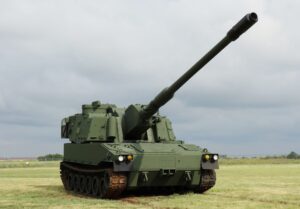HUNTSVILLE, Ala. — With the Army readying its new effort to get after extending the range of its cannon artillery, BAE Systems has said there’s potential interest in pursuing the requirement as it assesses the service’s new approach.
Jim Miller, BAE Systems’ vice president of business development for combat mission systems, told Defense Daily the company could potentially look to offer capabilities such as the M109-52 self-propelled howitzer that utilizes Rheinmetall’s L52 155mm, 52-caliber cannon or the Archer mobile artillery system, if the Army goes in a wheeled howitzer direction.

“It’s pretty obvious to me that we’re going to have to look at it pretty hard. And the reason I say that is [because] every howitzer the U.S. Army owns, we build it. We feel like this is kind of our space, so it’s going to be important to understand what the Army wants and make sure that we have a way to compete in that space. So, certainly inside the business it’s a pretty important focus area for us,” Miller said during an interview at AUSA’s Global Force Symposium here last week.
The Army recently announced it ended development of the Extended Range Cannon Artillery (ERCA) future howitzer system and will be pivoting to a new approach that will look to consider industry’s more mature, existing capabilities, with plans to assess offerings this summer (Defense Daily, March 12).
The ERCA development effort had focused around integrating an Army-developed 58-caliber, 30-foot gun tube on BAE Systems’ M109A7 self-propelled howitzer chassis with an aim to develop a system capable of hitting targets out to 70 kilometers at a rate of six to 10 rounds per minute.
Doug Bush, the Army’s acquisition chief, told reporters at the conference here last week that a Request for Information notice to officially begin the post-ERCA effort will gather insight on industry’s potential offerings that could go through the evaluation this summer (Defense Daily, March 27).
“We want to see what industry has on hand this summer through a series of evaluation events,” Bush said. “If that’s attractive to requirements holders, that would put us on a path to potentially selecting one next year to actually go into quick production off basically a… military off-the-shelf [capability] to get after the range issue…which is still there.”
“One thing about prototyping, this is where people talk about taking risks. They’re not all going to work out. The key thing is setting up the prototyping efforts where you gain knowledge early enough to make a decision to go in a different way or to go into production, either way before you’ve spent too much,” Bush added.
Miller confirmed to Defense Daily that BAE Systems will participate in the virtual industry day to hear more about the Army’s next steps and gather additional information to inform how it potentially responds to the RFI notice.
“We’ve already started asking questions and [the Army’s] been responsive. So we’re looking forward to what comes out of that [industry day],” Miller said. “We don’t usually talk about will we or will we not [participate]. But it’ll be interesting to hear what they’re expecting so we can make those decisions about if, how and should we respond to the RFI.”
“Because I don’t think anybody wants to go through another five, six years of, ‘Oh, that didn’t work.’ So, [the Army’s asking], ‘Can we do something that’s ready now? Can we get it to the guys and girls in our artillery units? Can we afford it? And how fast can we go?’ That’s kind of what we’re going to learn here over the next few weeks and months, I think,” Miller added.
Miller called BAE Systems’ M109-52 self-propelled howitzer project a potential “pretty low-cost, very fast way to go” for extending the range of cannon artillery.
“If you could do it on a production line that already exists and do it relatively cheaply and do it quickly, I think there’s a good argument for M109-52 to be able to go fast. I mean, the original ERCA gun was on an M109, so there’s a good argument there, I think, to do that,” Miller said.
BAE Systems first detailed the M109-52 this past October, noting it had successfully test fired current 155mm projectiles out to ranges of 60 kilometers from an M109A7 howitzer modified with the Rheinmetall L52 155mm, 52-caliber cannon.
“We’ve demonstrated that the integrated system of the M109-52 is a viable solution for long-range precision fires modernization needs,” Dan Furber, director of ground vehicle production for BAE Systems’ combat mission systems business, said in a statement at the time. “Integrating these two highly capable and proven artillery systems provides stable designs and predictable performance.”
Miller pointed to BAE Systems’ Archer mobile artillery capability as a potential option to showcase for the Army if the service takes a wheeled howitzer approach for this requirement, noting the the U.K. and Sweden have the system and that’s also been used in Ukraine.
“It’s got great capability and it’s combat proven and it’s wheeled. That might be an option they’re looking for,” Miller told Defense Daily.
BAE Systems in December announced its teaming with British defense firm Babcock and the Rheinmetall BAE Systems Land joint venture to offer Archer for the U.K.’s upcoming program to field a new 155mm howitzer platform (Defense Daily, Dec. 11).
The U.K. had previously tapped BAE Systems to provide 14 Archer systems as an interim 155mm artillery solution to replace the legacy AS-90 platforms it donated to assist Ukraine.
Miller last week also detailed a live fire test BAE Systems conducted in December with its new XM1155-SC long-range artillery projectile where it demonstrated the munition’s maneuvering capabilities (Defense Daily, April 1).